Semicontinuous Process of Rare Earths Recovery from End-of-Life NdFeB Magnets on a Large Laboratory Scale
Abstract
:1. Introduction
2. Materials and Methods
2.1. Methodology Background
2.2. Materials
2.3. Leaching and Precipitation Procedure
2.4. Experimental Procedure in the Larger Laboratory Scale
2.5. Thermal Decomposition of Rare Earth Oxalates
2.6. Chemical Analysis of Solutions and Solids
3. Results and Discussion
3.1. Recirculation of the Solution in the Leaching–Precipitation Cycle
3.2. Leaching–Precipitation Cycles on the Larger Laboratory Scale
3.3. Thermal Decomposition of Rare Earth Oxalates
3.4. Further Considerations
4. Summary and Conclusions
Supplementary Materials
Author Contributions
Funding
Data Availability Statement
Acknowledgments
Conflicts of Interest
References
- Bromberg, L.; Hashizume, H.; Ito, S.; Minervini, J.V.; Yanagi, N. Status of high temperature superconducting magnet development. Plasma Sci. Fusion. Cent. MIT 2010, 60, 635–642. Available online: http://dspace.mit.edu/bitstream/handle/1721.1/94387/10ja045_full.pdf;sequence=1 (accessed on 16 May 2023). [CrossRef]
- Ganguli, R.; Cook, D. Rare earths: A review of the landscape. MRS Energy Sustain. 2018, 5, 1–16. [Google Scholar] [CrossRef] [Green Version]
- Uysal, E.; Al, S.; Emil-Kaya, E.; Stopic, S.; Gürmen, S.; Friedrich, B. Hydrometallurgical recycling of waste NdFeB magnets: Design of experiment, optimisation of low concentrations of sulphuric acid leaching and process and analysis. Can. Metall. Q. 2023, 62, 107–118. [Google Scholar] [CrossRef]
- Communication from the Commission to the European Parliament, the Council, the European Economic and Social Committee and Committee of Regions Critical Raw Materials Resilience: Charting a Path towards Greater Security and Sustainability; European Commission: Brussel, Belgium, 2020; Available online: https://eur-lex.europa.eu/legal-content/EN/TXT/?uri=CELEX:52020DC0474 (accessed on 25 April 2023).
- Firdaus, M.; Rhamdhani, M.A.; Durandet, Y.; Rankin, W.J.; McGregor, K. Review of High-Temperature Recovery of Rare Earth (Nd/Dy) from Magnet Waste. J. Sustain. Metall. 2016, 2, 276–295. [Google Scholar] [CrossRef] [Green Version]
- Yang, Y.; Walton, A.; Sheridan, R.; Gu, K.; Gauß, R.; Gutfleisch, O.; Buchert, M.; Steenari, B.M.; Van Gerven, T.; Jones, P.T.; et al. REE Recovery from End-of-Life NdFeB Permanent Magnet Scrap: A Critical Review. J. Sustain. Metall. 2017, 3, 122–149. [Google Scholar] [CrossRef]
- Zhang, Y.; Gu, F.; Su, Z.; Liu, S.; Anderson, C.; Jiang, T. Hydrometallurgical Recovery of Rare Earth Elements from NdFeB Permanent Magnet Scrap: A Review. Metals 2020, 10, 841. [Google Scholar] [CrossRef]
- Karal, E.; Kucuker, M.A.; Demirel, B.; Copty, N.K.; Kuchta, K. Hydrometallurgical recovery of neodymium from spent hard disk magnets: A life cycle perspective. J. Clean. Prod. 2021, 288, 125087. [Google Scholar] [CrossRef]
- Baba, K.; Hiroshige, Y.; Nemoto, T. Rare-earth Magnet Recycling. Hitachi Rev. 2013, 62, 8. Available online: https://www.hitachi.com/rev/pdf/2013/r2013_08_105.pdf (accessed on 16 May 2023).
- Zakotnik, M.; Afiuny, P.; Dunn, S.; Tudor, C.O. Magnet Recycling to Create Nd–Fe–B Magnets with Improved or Restored Magnetic Performance. U.S. Patent Application Number 20140369881, 18 December 2014. [Google Scholar]
- McGuiness, P.J.; Devlin, E.; Harris, I.R. A study of Nd-Fe-B magnets produced using a combination of hydrogen decrepitation and jet milling. J. Mater. Sci. 1989, 24, 2541–2548. [Google Scholar] [CrossRef]
- Zakotnik, M.; Harris, I.R.; Williams, A.J. Hydrogen decrepitation and recycling of sintered NdFeB-type sintered magnets. In Proceedings of the 19th International Workshop on Rare Earth Permanent Magnets & Their Applications, Beijing, China, 30 August–2 September 2006; pp. 289–295. [Google Scholar]
- Zakotnik, M.; Harris, I.R.; Williams, A.J. Possible methods of recycling NdFeB-type sintered magnets using the HD/degassing process. J. Alloys Compd. 2008, 450, 525–531. [Google Scholar] [CrossRef]
- Zakotnik, M.; Harris, I.R.; Williams, A.J. Multiple recycling of NdFeB-type sintered magnets. J. Alloys Compd. 2009, 469, 314–321. [Google Scholar] [CrossRef]
- Available online: https://noveon.co/our-process (accessed on 16 May 2023).
- Polyakov, E.G.; Sibilev, A. Recycling Rare-Earth-Metal Waste Using Hydrometallurgical Methods. Theor. Found. Chem. Eng. 2016, 50, 607–612. [Google Scholar] [CrossRef]
- Arrachart, G.; Couturier, J.; Dourdain, S.; Levard, C.; Pellet-Rostaing, S. Recovery of Rare Earth Elements (REEs) Using Ionic Solvents. Processes 2021, 9, 1202. [Google Scholar] [CrossRef]
- Zhu, F.M.N.; Zhu, W.; Liu, B.; Wu, P.; Dang, Z. Efficient recovery of rare earth elements from discarded NdFeB magnets by mechanical activation coupled with acid leaching. Environ. Sci. Pollut. Res. 2022, 29, 25532–25543. [Google Scholar] [CrossRef]
- Klemettinen, A.; Żak, A.; Chojnacka, I.; Matuska, S.; Lesniewicz, A.; Wełna, M.; Adamski, Z.; Klemettinen, L.; Rycerz, L. Leaching of Rare Earth Elements from NdFeB Magnets without Mechanical Pretreatment by Sulfuric (H2SO4) and Hydrochloric (HCl) Acids. Minerals 2021, 11, 1374. [Google Scholar] [CrossRef]
- Klemettinen, A.; Adamski, Z.; Chojnacka, I.; Lesniewicz, A.; Rycerz, L. Recovery of Rare Earth Elements from the Leaching Solutions of spent NdFeB Magnets by Selective Precipitation of Rare Earth Oxalates. Minerals 2023, 13, 846. [Google Scholar] [CrossRef]
- Haynes, W.M. Basic constants, Units and Conversion Factors. In CRC Handbook of Chemistry and Physics, 95th ed.; Taylor and Francis Group: Boca Raton, FL, USA, 2013; pp. 5–190. [Google Scholar] [CrossRef]
- Vander Hoogerstraete, T.; Blanpain, B.; Van Gerven, T.; Binnemans, K. From NdFeB magnets towards the rare-earth oxides: A recycling process consuming only oxalic acid. RSC Adv. 2014, 4, 64099–64111. [Google Scholar] [CrossRef] [Green Version]
- Danczak, A.; Chojnacka, I.; Matuska, S.; Marcola, K.; Lesniewicz, A.; Wełna, M.; Żak, A.; Adamski, Z.; Rycerz, L. The recycling-oriented material characterization of hard disk drives with special emphasis on NdFeB magnets. Physicochem. Probl. Miner. Process. 2018, 54, 363–376. [Google Scholar] [CrossRef]
- Benson, J.; Celin, A. Recovering Hydrogen—And Profits—From Hydrogen-Rich Offgas. Reactions and Separations. 2018. Available online: https://www.aiche.org/resources/publications/cep/2018/january/recovering-hydrogen-and-profits-hydrogen-rich-offgas (accessed on 21 June 2023).
- Xiao, F.; Hu, W.; Zhao, J.; Zhu, H. Technologies of Recycling REEs and Iron from NdFeB Scrap. Metals 2023, 13, 779. [Google Scholar] [CrossRef]
- Yang, Y.; Wang, X.; Wang, M.; Wang, H.; Xian, P. Iron recovery from the leached solution of red mud through the application of oxalic acid. Int. J. Miner. Process. 2016, 157, 145–151. [Google Scholar] [CrossRef]
- Pietrantonio, M.; Pucciarmati, S.; Sebastianelli, L.; Forte, F.; Fontana, D. Materials recovery from end-of-life wind turbine magnets. Int. J. Environ. Sci. Technol. 2022, 19, 8019–8026. [Google Scholar] [CrossRef]
- Mystrioti, C.; Papassiopi, N.; Xenidis, A. Selective Recovery of Iron by Solvent Extraction from Ni-Laterite Leach Solutions, as Precursor for the Synthesis of High Added-Value Nanomaterials. Circ. Econ. Sustain. 2022, 2, 1575–1587. [Google Scholar] [CrossRef]
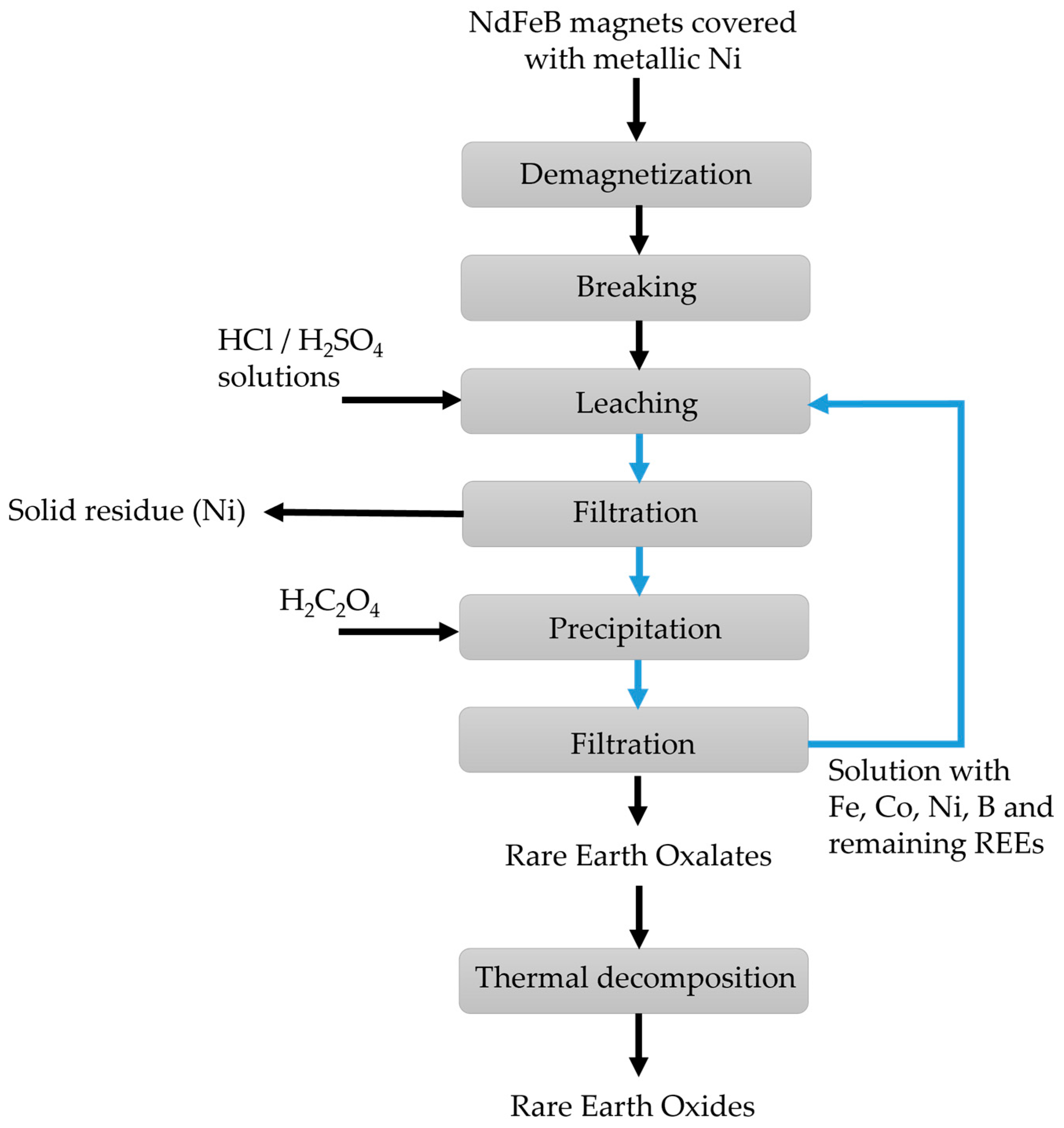
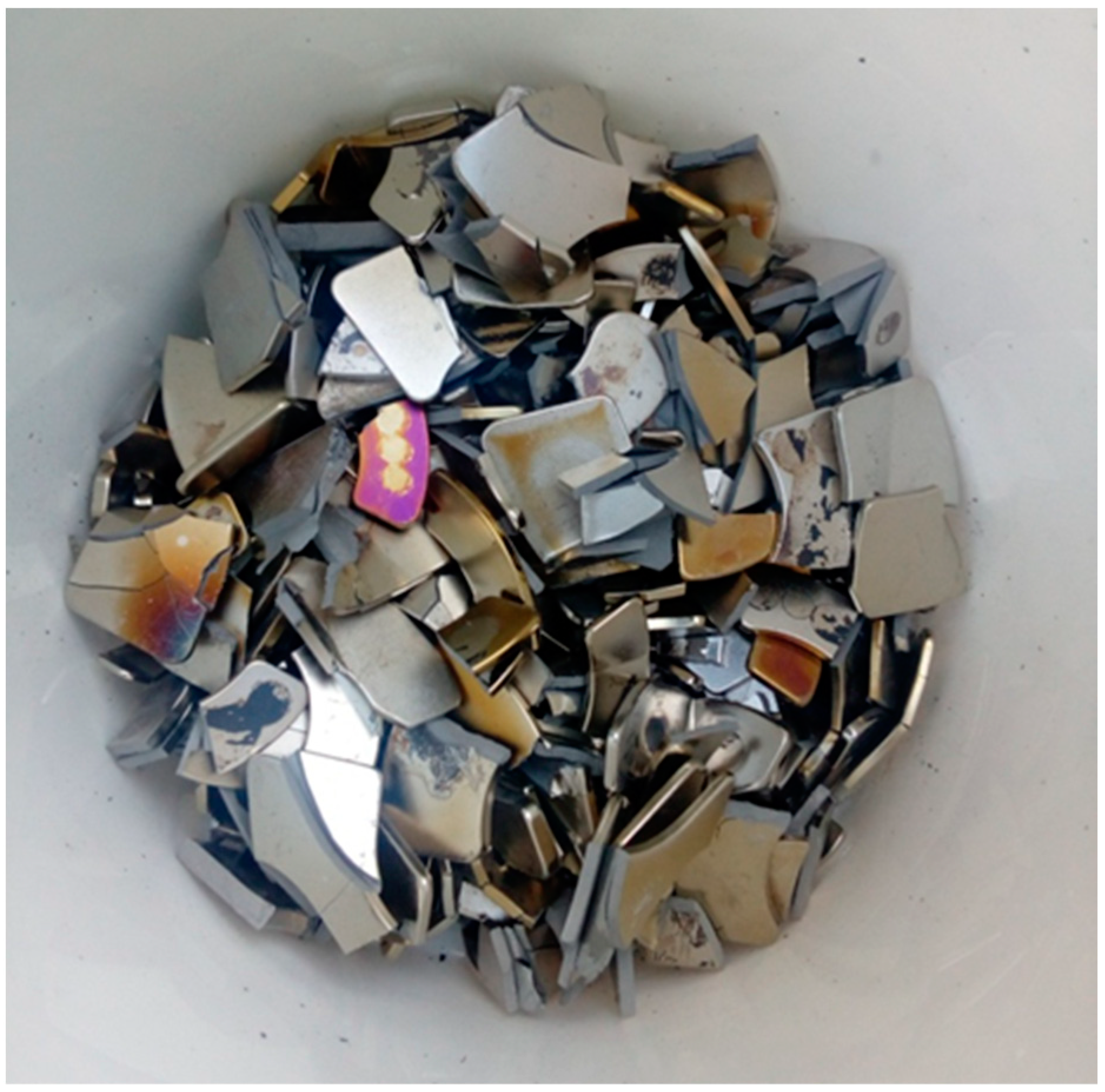
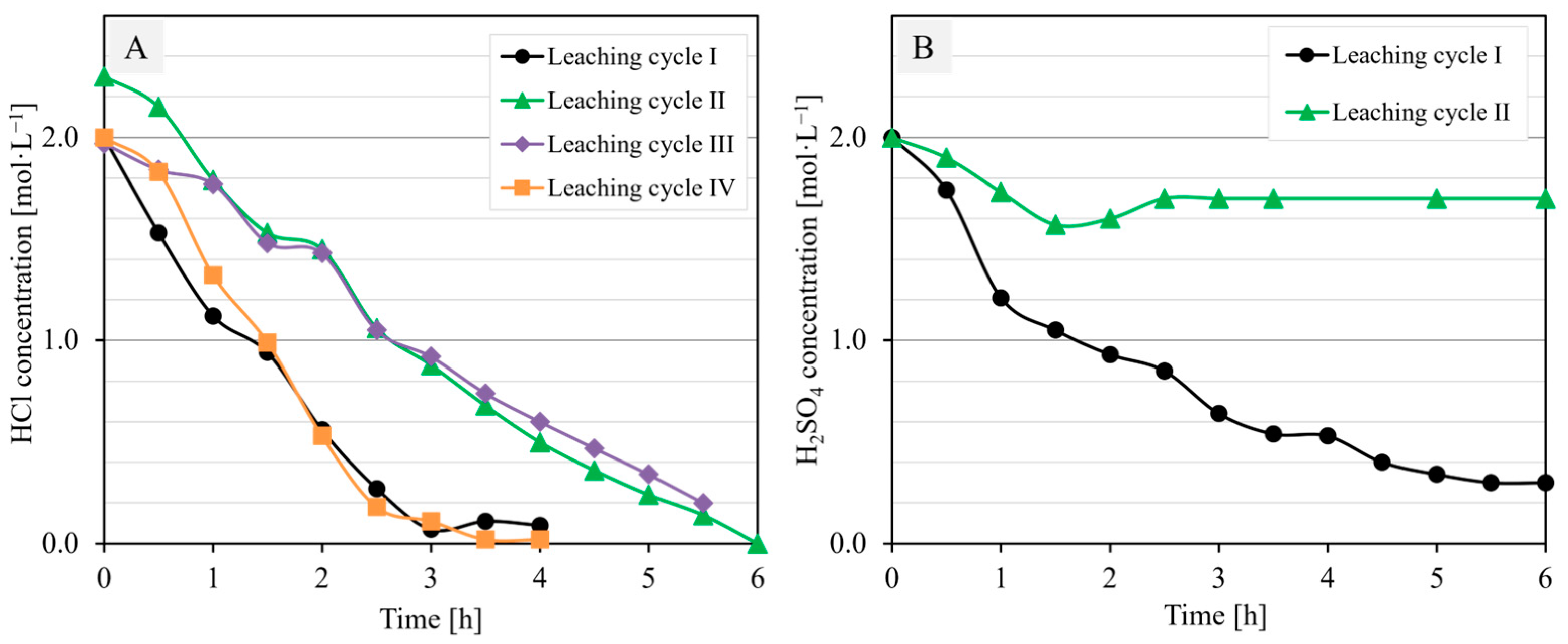
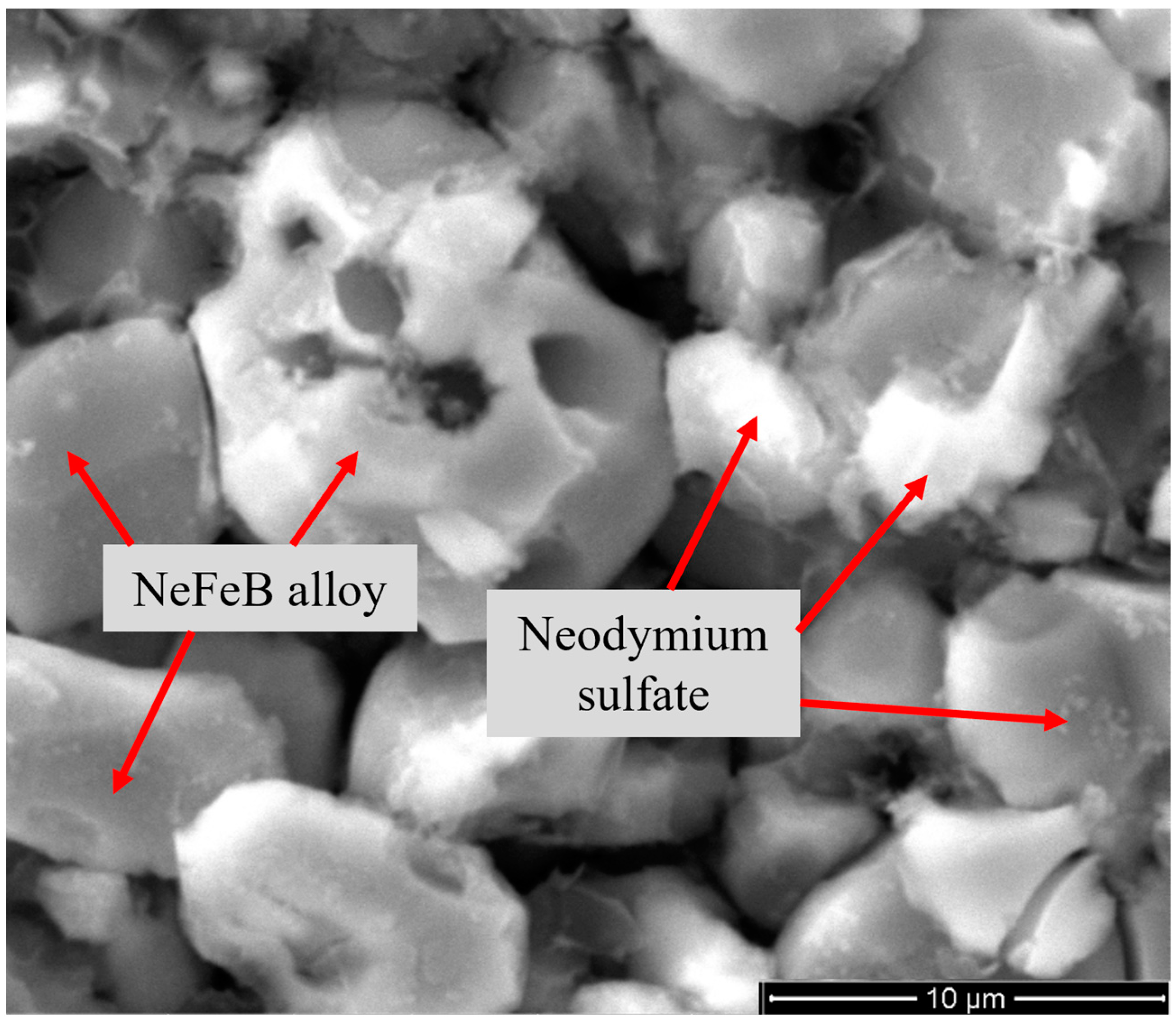
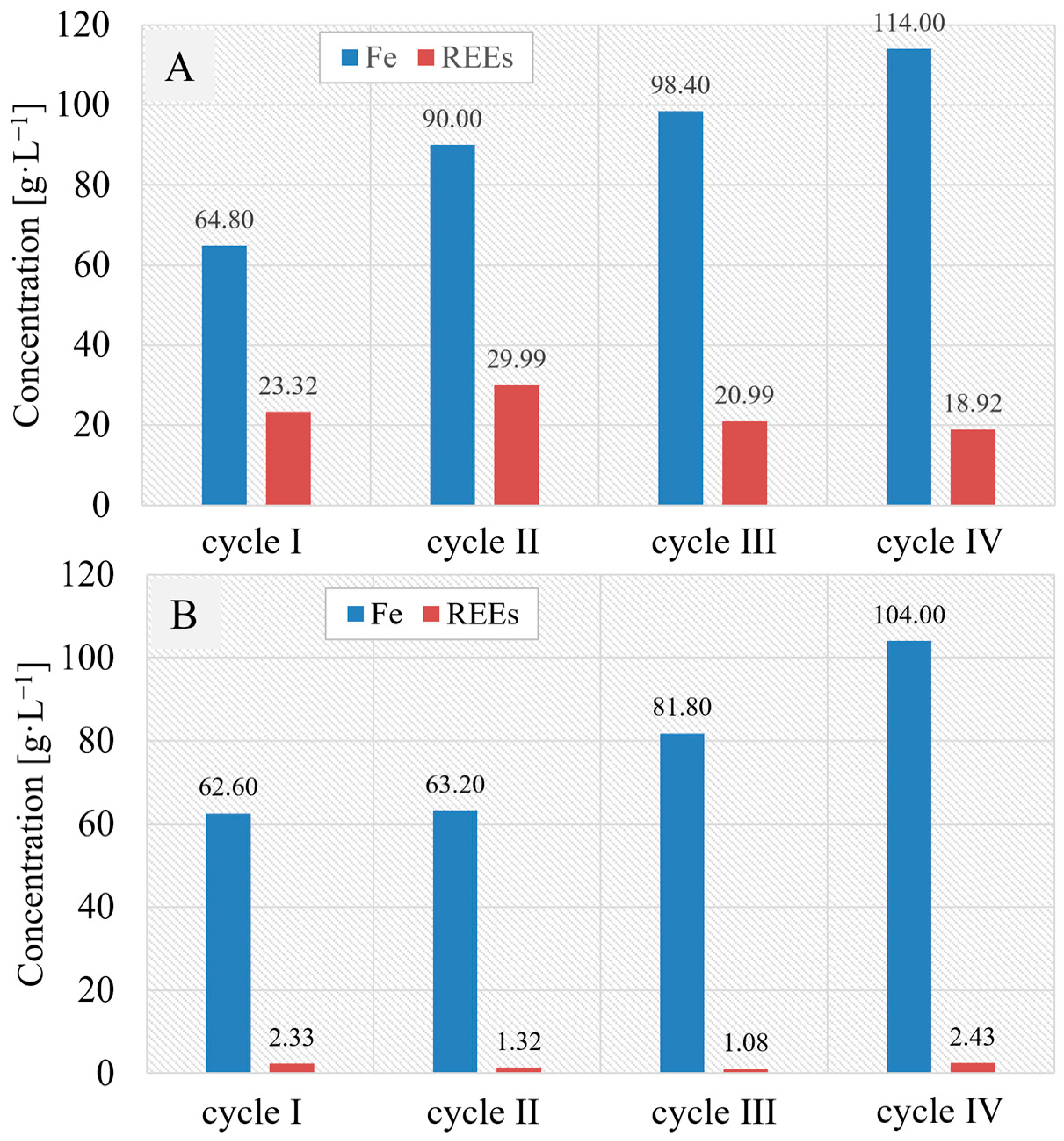
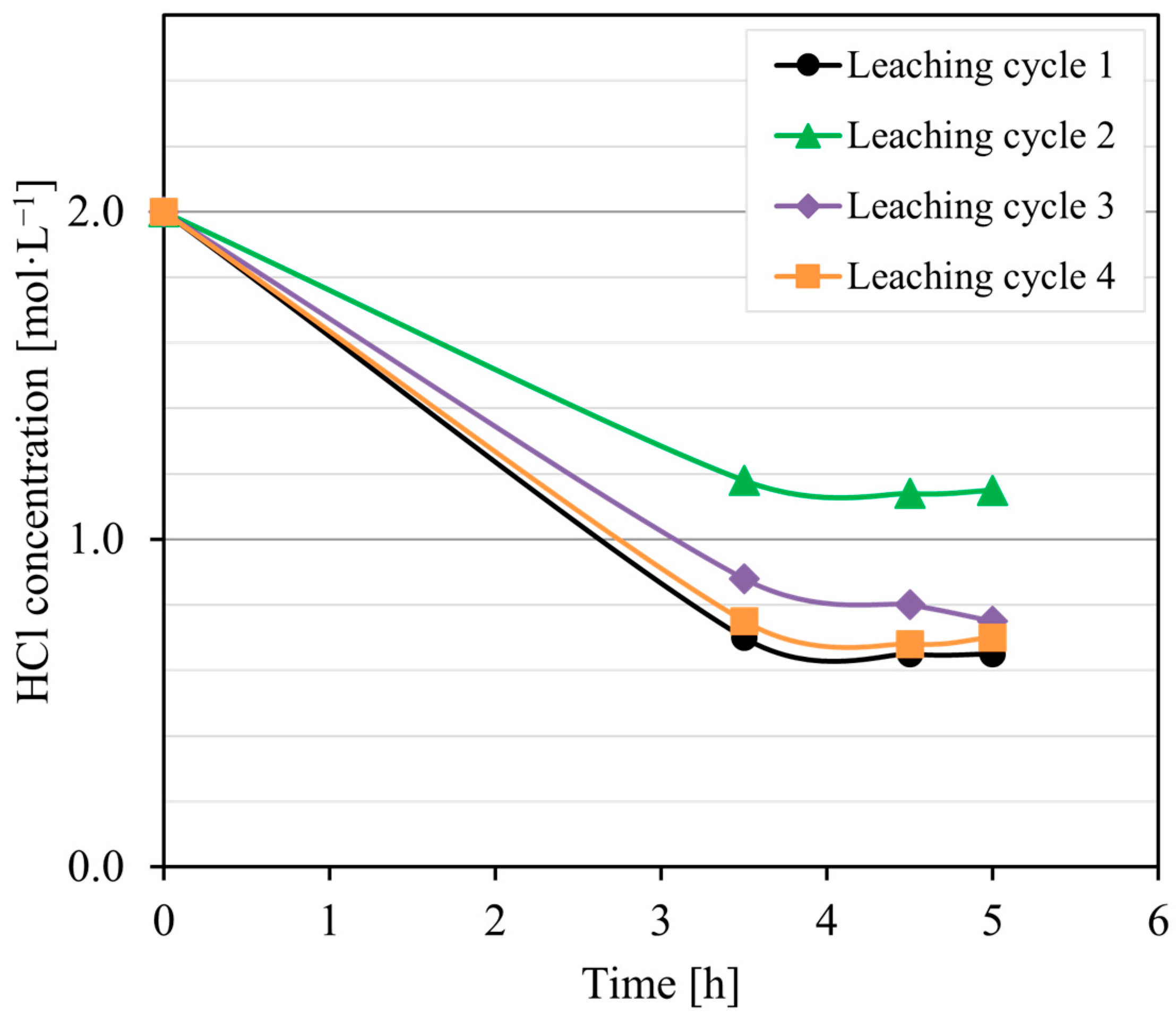
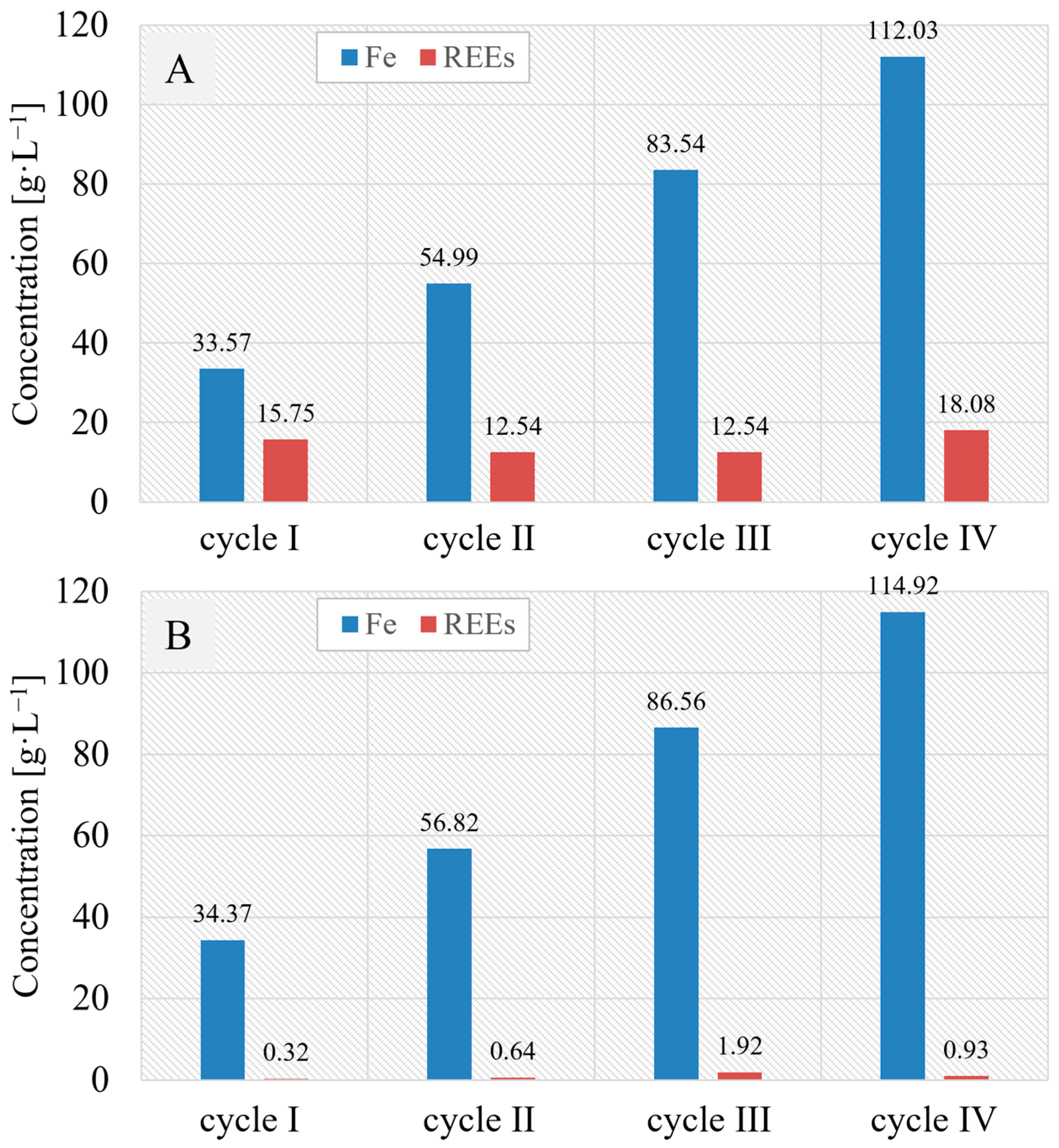

| Chemical | Formula | Purity | Supplier |
|---|---|---|---|
| Sulfuric(VI) acid | H2SO4 | Min. 95% | POCH SA, Gliwice, Poland |
| Hydrochloric acid | HCl | 35% | POCH SA, Gliwice, Poland |
| Ethylenediaminetetraacetic acid disodium salt | quality level 100 | MerckGroup, Darmstadt, Germany | |
| Calcium chloride | CaCl2 | Min. 96% | CHEMPUR, Piekary Śląskie, Poland |
| Oxalic acid dihydrate | C2H2O4·H2O | Min. 96% | POCH SA, Gliwice, Poland |
| Cycle | Weight [g] | ||||
|---|---|---|---|---|---|
| Leach Feed | Solid Residue from Leaching | Oxalic Acid Added in Precipitation | Precipitated Oxalates | ||
| Magnets Fed to the Leaching | Solid Residue from Leaching | ||||
| I | 1040 | 300 | 300 | 470 | 862 |
| II | 740 | 350 | 350 | 320 | 519 |
| III | 1040 | 470 | 470 | 330 | 571 |
| IV | 1040 | 600 | 600 | 410 | 617 |
| Cycle | Weight of Rare Earth Oxalates after Precipitation [g] | Weight of Rare Earth Oxides after Thermal Treatment [g] | Weight of Fe [g] in 1 kg of Oxides |
|---|---|---|---|
| I | 862 | 431 | 4.92 |
| II | 519 | 199 | 8.95 |
| III | 571 | 194 | 13.72 |
| IV | 617 | 276 | 14.91 |
| SUM | 2569 | 1100 | 42.50 |
Disclaimer/Publisher’s Note: The statements, opinions and data contained in all publications are solely those of the individual author(s) and contributor(s) and not of MDPI and/or the editor(s). MDPI and/or the editor(s) disclaim responsibility for any injury to people or property resulting from any ideas, methods, instructions or products referred to in the content. |
© 2023 by the authors. Licensee MDPI, Basel, Switzerland. This article is an open access article distributed under the terms and conditions of the Creative Commons Attribution (CC BY) license (https://creativecommons.org/licenses/by/4.0/).
Share and Cite
Klemettinen, A.; Adamski, Z.; Leśniewicz, A.; Rycerz, L. Semicontinuous Process of Rare Earths Recovery from End-of-Life NdFeB Magnets on a Large Laboratory Scale. Minerals 2023, 13, 862. https://doi.org/10.3390/min13070862
Klemettinen A, Adamski Z, Leśniewicz A, Rycerz L. Semicontinuous Process of Rare Earths Recovery from End-of-Life NdFeB Magnets on a Large Laboratory Scale. Minerals. 2023; 13(7):862. https://doi.org/10.3390/min13070862
Chicago/Turabian StyleKlemettinen, Anna, Zbigniew Adamski, Anna Leśniewicz, and Leszek Rycerz. 2023. "Semicontinuous Process of Rare Earths Recovery from End-of-Life NdFeB Magnets on a Large Laboratory Scale" Minerals 13, no. 7: 862. https://doi.org/10.3390/min13070862
APA StyleKlemettinen, A., Adamski, Z., Leśniewicz, A., & Rycerz, L. (2023). Semicontinuous Process of Rare Earths Recovery from End-of-Life NdFeB Magnets on a Large Laboratory Scale. Minerals, 13(7), 862. https://doi.org/10.3390/min13070862







